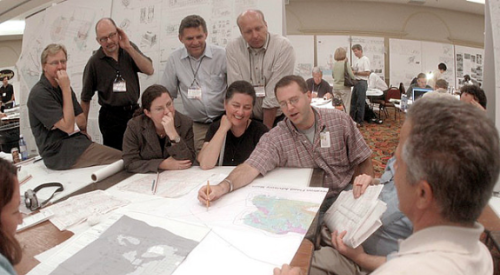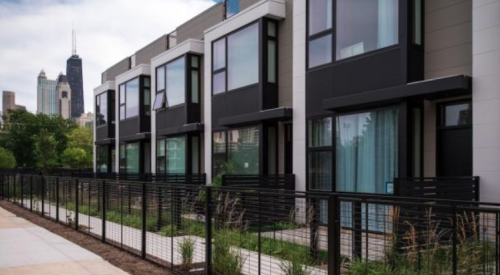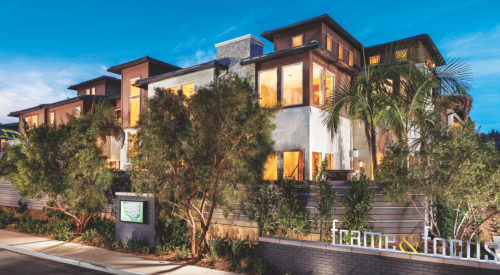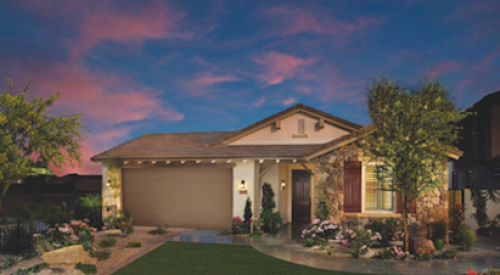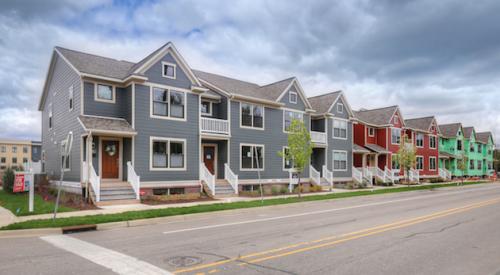| In addition to a gazebo and open space, MillCreek’s town square includes the Ring of Friendship, a walkway that features the handprints of everyone involved in the project - buyers, project partners, the mayor, workers and others. |
Ten years ago, you would have been hard-pressed to find someone who had anything positive to say about the home building business in Cleveland. In 1990, with a population of 505,616, the city issued a paltry 53 housing permits.
In contrast to Sun Belt cities struggling to get enough homes built to house their inhabitants affordably, Cleveland is making an all-out effort merely to attract more people. Led by Mayor Michael R. White, who has made a commitment to bring more people back into the city, Cleveland is on the cusp of a major urban renewal that starts with new housing. Things are looking good. In 2000, despite a population dip to 478,403, housing starts increased to 223.
Nathan Zaremba is a pioneer in the movement to attract newcomers. A nonprofit organization handpicked his company, Zaremba Cleveland Communities, to be the builder for the new home community of MillCreek on the southeast side of Cleveland. Named for the 11-mile creek that runs through the site, MillCreek is the largest single-family development built in Cleveland in more than 50 years.
Hometown Heroes
| The Hawthorne’s front porch, alley-loaded garage, and traditional style and finishes are reminiscent of homes in old Cleveland neighborhoods. |
In 1990, the nonprofit Broadway Area Housing Coalition, now known as Slavic Village Development, acquired the 100-acre property from the state of Ohio with help from the city of Cleveland. Since its donation in 1855 by Thomas Garfield, uncle of President James Garfield, the site had been home to state mental institutions, but use of the land had been totally unregulated. When the BAHC took it over and razed the buildings, it found construction debris, the asbestos-encased pipes of an underground steam plant, leaky gasoline storage tanks and a 6.5-acre impromptu landfill with hospital beds, wheelchairs and appliances.
Foundation and grant money allowed the BAHC to draft preliminary plans for a housing development that would include more than 200 residential units, trails and park area for the Cleveland Metroparks system. The city took on the task of cleaning up the site’s contamination, but developing the property, which was still littered with more than 130 years’ worth of debris and old foundations, was up to the builder.
Finding a builder who would shoulder that risk, plus be the first to attempt to turn around a decades-long slump in urban home construction, was no easy feat. Only three builders responded to the BAHC’s 14 visits to builders and requests for proposals, and Zaremba wasn’t one of them. Nobody wanted to touch it.
In the preliminary planning stages of MillCreek, however, a BAHC advisory board that included residents from the surrounding neighborhood toured suburban communities extensively and concluded that Zaremba Cleveland Communities’ MacIntosh Farms in Broadview Heights, modeled after a fishing village in Key West, Fla., exemplified the kind of neighborhood-oriented, pedestrian-friendly community that board members wanted to see at MillCreek. BAHC development officer and target area manager Bobbi Reichtell approached Nathan Zaremba with the MillCreek idea, and after submitting a proposal, Zaremba’s company was chosen as the sole builder.
The grandson of Polish immigrants to the Slavic Village area surrounding MillCreek, Zaremba had an emotional connection to the site. Add his hunger for a new challenge, and Zaremba was in. Even so, going from building in suburbia to building in a city desperate for growth, Zaremba found himself in a new world.
"The early years were very painful - it sometimes felt like a wasted effort," he says. "When you work with a city that hasn’t done anything in 50 years, you literally have to create programs every step of the way. The building codes and the planning commission were geared strictly toward industrial." Still, he says, "The city has been absolutely phenomenal - they’ve lived up to every commitment."
Building a Community
| Even at just 1,395 square feet, the Newberry II, priced at $184,000, contains many features buyers might expect in a $500,000 home. A proper foyer, a hall closet, and connected bathroom and closets in the master suite are essentials for Zaremba Cleveland Communities designs. |
Zaremba’s deal with the BAHC and the city - he bought the undeveloped land at $100 a lot for the 222 lots - didn’t specify a certain kind of housing. In contrast to most public/private housing deals, MillCreek required no affordability component, and Zaremba chose to build strictly market-rate housing. He and the BAHC, however, were determined to create a diverse community. "We concluded early on that we wanted this development to be very integrated, both racially and agewise," Reichtell says.
A fair-housing group helped them develop a marketing plan to reach out to underserved markets. "Ideally we’d have 111 majority buyers and 111 minority buyers," Zaremba says. "We wanted it to be a success as a real estate project but thought it should also make a positive impact in the community."
It has been successful in both senses. Since sales opened in late 1996, MillCreek’s prices have risen among the fastest in Cleveland, going from a range of $119,000 to $160,000 up to $137,000 to $225,000 in the past 21/2 years. In phase four of five, MillCreek’s 125 sales have included a balanced mix of buyers. Besides being racially diverse - numbers of majority and minority buyers are neck and neck - the ratio of blue-collar to white-collar workers is about 40:60, Zaremba says. More than half the buyers are suburbanites moving to the city for the first time.
Although less than 10% of the buyers at MillCreek are from the surrounding neighborhoods, Zaremba, the BAHC and the city partnered with community groups to provide meeting space and recreational facilities for the greater community. A critical component was the reservation and environmental cleanup of 35 acres of park area given to the Cleveland Metroparks system. The hiking and biking trails at MillCreek will eventually link with CanalWay Ohio, a 110-mile greenway extending south from Cleveland along the Ohio Canal.
Zaremba describes MillCreek’s look and feel as very traditional. He says he had been thinking about New Urbanism for some time, and when he saw the original suburban-type site design, he swiftly altered it to make the project more like an older city neighborhood, opting for connecting streets, alleys and a town center with a gazebo and grassy area. "Why should we ignore the neighborhoods around us?" he asks. "What makes them work and why people like the old neighborhoods of Cleveland is the pedestrian-oriented scale.
"When you drive down the street [at MillCreek], you get the feeling you’re in a 100-year-old community - except the trees are too small."
Drawing from the architectural vernacular of Cleveland, City Architecture of Cleveland created three product lines composed of 13 homes and a variety of floor plans. The two single-family lines - the Courtyard Homes, with rear-loaded, alley-fed garages, front porches and private side yards; and the Creekside Homes, with larger square footages, front-loaded garages and lots adjacent to Mill Creek - have been the best-selling homes, accounting for 101 sales. The Mainstreet Homes are two-family attached homes that resemble single-family residences. Although several are above the $183,994 average price for a new home in Cleveland, the homes at MillCreek are rather affordable, Zaremba says.
When all is said and done, Zaremba tips his hat to the public and private partners in MillCreek that made its creation possible. "I found a little niche, and I’m happy to do it," he says, "but nonprofits have been fighting for decades to make a place for builders to come in [and build affordable housing].
"All the other builders think I’m a nut. It’s hard work - it’s much easier to do a suburban development - but it makes you feel good at the end of the day."
Also See
Urban Pioneers
Lofty Ambitions
Anchoring a Reborn Neighborhood
